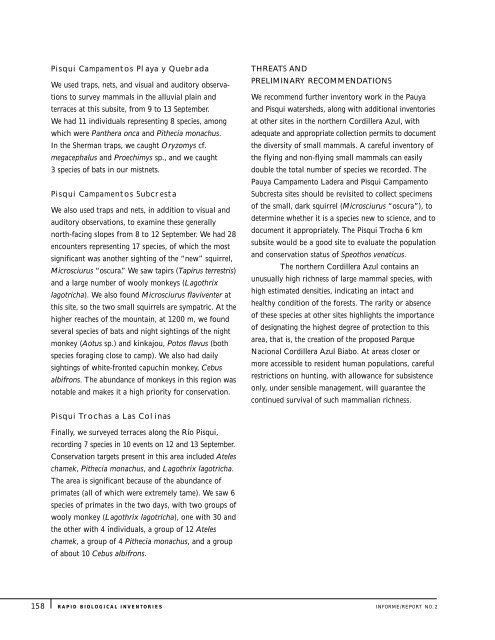RBI 02: Cordillera Azul - Espanol - The Field Museum
RBI 02: Cordillera Azul - Espanol - The Field Museum
RBI 02: Cordillera Azul - Espanol - The Field Museum
You also want an ePaper? Increase the reach of your titles
YUMPU automatically turns print PDFs into web optimized ePapers that Google loves.
158<br />
Pisqui Campamentos Playa y Quebrada<br />
We used traps, nets, and visual and auditory observations<br />
to survey mammals in the alluvial plain and<br />
terraces at this subsite, from 9 to 13 September.<br />
We had 11 individuals representing 8 species, among<br />
which were Panthera onca and Pithecia monachus.<br />
In the Sherman traps, we caught Oryzomys cf.<br />
megacephalus and Proechimys sp., and we caught<br />
3 species of bats in our mistnets.<br />
Pisqui Campamentos Subcresta<br />
We also used traps and nets, in addition to visual and<br />
auditory observations, to examine these generally<br />
north-facing slopes from 8 to 12 September. We had 28<br />
encounters representing 17 species, of which the most<br />
significant was another sighting of the “new” squirrel,<br />
Microsciurus “oscura.” We saw tapirs (Tapirus terrestris)<br />
and a large number of wooly monkeys (Lagothrix<br />
lagotricha). We also found Microsciurus flaviventer at<br />
this site, so the two small squirrels are sympatric. At the<br />
higher reaches of the mountain, at 1200 m, we found<br />
several species of bats and night sightings of the night<br />
monkey (Aotus sp.) and kinkajou, Potos flavus (both<br />
species foraging close to camp). We also had daily<br />
sightings of white-fronted capuchin monkey, Cebus<br />
albifrons. <strong>The</strong> abundance of monkeys in this region was<br />
notable and makes it a high priority for conservation.<br />
Pisqui Trochas a Las Colinas<br />
Finally, we surveyed terraces along the Río Pisqui,<br />
recording 7 species in 10 events on 12 and 13 September.<br />
Conservation targets present in this area included Ateles<br />
chamek, Pithecia monachus, and Lagothrix lagotricha.<br />
<strong>The</strong> area is significant because of the abundance of<br />
primates (all of which were extremely tame). We saw 6<br />
species of primates in the two days, with two groups of<br />
wooly monkey (Lagothrix lagotricha), one with 30 and<br />
the other with 4 individuals, a group of 12 Ateles<br />
chamek, a group of 4 Pithecia monachus, and a group<br />
of about 10 Cebus albifrons.<br />
THREATS AND<br />
PRELIMINARY RECOMMENDATIONS<br />
We recommend further inventory work in the Pauya<br />
and Pisqui watersheds, along with additional inventories<br />
at other sites in the northern <strong>Cordillera</strong> <strong>Azul</strong>, with<br />
adequate and appropriate collection permits to document<br />
the diversity of small mammals. A careful inventory of<br />
the flying and non-flying small mammals can easily<br />
double the total number of species we recorded. <strong>The</strong><br />
Pauya Campamento Ladera and Pisqui Campamento<br />
Subcresta sites should be revisited to collect specimens<br />
of the small, dark squirrel (Microsciurus “oscura”), to<br />
determine whether it is a species new to science, and to<br />
document it appropriately. <strong>The</strong> Pisqui Trocha 6 km<br />
subsite would be a good site to evaluate the population<br />
and conservation status of Speothos venaticus.<br />
<strong>The</strong> northern <strong>Cordillera</strong> <strong>Azul</strong> contains an<br />
unusually high richness of large mammal species, with<br />
high estimated densities, indicating an intact and<br />
healthy condition of the forests. <strong>The</strong> rarity or absence<br />
of these species at other sites highlights the importance<br />
of designating the highest degree of protection to this<br />
area, that is, the creation of the proposed Parque<br />
Nacional <strong>Cordillera</strong> <strong>Azul</strong> Biabo. At areas closer or<br />
more accessible to resident human populations, careful<br />
restrictions on hunting, with allowance for subsistence<br />
only, under sensible management, will guarantee the<br />
continued survival of such mammalian richness.<br />
RAPID BIOLOGICAL INVENTORIES INFORME/REPORT NO.2

















